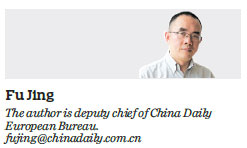High tariffs will not solve US, EU structural problems
On March 6, the European Commission decided to extend the existing anti-dumping tariffs, from 48.3 percent to 71.9 percent, on Chinese seamless pipes and stainless steel tubes for another five years. A day later, the EC raised its pitch higher, saying it stands ready to retaliate "proportionately and fully in line with the World Trade Organization rules" against US President Donald Trump imposing tariffs of 25 percent on steel imports and 10 percent on aluminum imports, except those from Canada and Mexico.
Before the United States decided to impose the tariffs to "protect" the US economy, the European Union had been urging it to remove the European bloc from the list of targets because the two sides were allies and security partners.

In response to the US move, steel producing economies such as the EU and China have threatened to levy import duties on US exports. Also, China might consider taking action against the EC's decision to extend the tariffs on Chinese seamless pipes and stainless steel tubes. If the US, too, targets China, the price of retaliation will be high as well.















